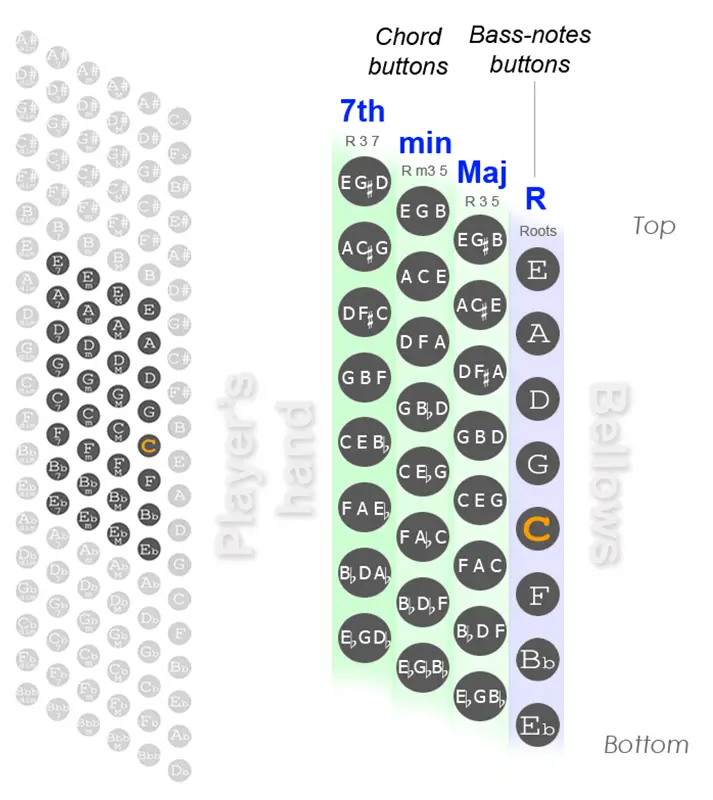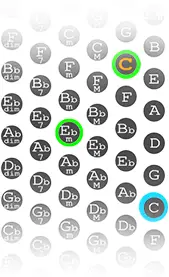The 32 bass is a small accordion that is perfect for children who want to learn to play the instrument. It’s also a good choice for adults who are just getting started on the accordion. It has 1 column of single bass notes, 3 columns of chord buttons (Major, minor, and Dominant 7th), and 8 rows. Compared to the smaller model (the 24 bass layout), it has the same number of Roots (from E to Eb) and an extra column of chords (Dominant 7th chords). The 4 missing keys are (F#/Gb), B, (Ab/G#), (Db/C#). It has no counter basses nor diminished chords.
If you are totally new to the Stradella bass system, read this article.
32 Bass Accordion Layout

All chords you can play on a 32 Bass Accordion
There are three columns of standard chords:
- 8 major chords
- 8 minor chords
- 8 dominant 7th chords
in the keys of E, A, D, G, C, F, Bb, and Eb, however, combining chords and roots you can get:
- 2 Dominant 7th flat 5th chords
- 4 Major 7th chords
- 5 minor 7th chords
- 5 Half-diminished chords
- 5 Major 6th chords
- 6 Dominant 11th chords
- 6 Dominant 9th sus4 chords
- 7 Dominant 9th chords
- 7 Major 7th/9th chords
- 7 minor(Major 9th) chords
- 7 minor 9th chords
How to read the lists of chords
Here are some guidelines to help you read the following lists of chords and charts:
- Flats and sharps are paired with their enharmonic equivalent chord, for example, C#Maj7 = DbMaj7
- Chords that can be played are clickable and are colored in dark red, for example, DMaj
- Chords that can’t be played are colored in gray and are crossed out by a horizontal line, for example,
Bdim7. - Duplicated chords are colored in light blue, for example, E#m7 = Fm7
- Some chords can be played in two different ways:
-
- by combining a chord with a bass note or
- by combining a chord with a counter-bass button.

The charts of those extended chords that can be built combining a chord with a counter bass or with a bass note, show both positions: counter basses are circled in blue, and basses are circled in green.
Usually, the green pattern is the most common and convenient. However, in some cases, it could be easier to play the root on the counter bass column.
For this reason, you’ll find two lists for the same group of chords, one for those that can be played combining a counter bass with a chord (“On Counter Bass” list) and one for those chords that can be played combining a bass note (“On Root” list).
Standard chords
8 Major chords
Major chords are built with a Root (R), a major third (3rd), and a perfect fifth (5th).
On a 32 bass accordion you can play these Major chords:
F#Maj = GbMajBMaj- EMaj
- AMaj
- DMaj
- GMaj
- CMaj
- FMaj
- BbMaj = A#Maj
- EbMaj = D#Maj
AbMaj = G#MajDbMaj = C#Maj
8 Minor chords
Minor chords are built with a Root (R), a minor third (m3rd), and a perfect fifth (5th).
On a 32 bass accordion you can play these minor chords:
8 Dominant 7th (5th omitted) chords
Dominant 7th chords are Major chords with a minor 7th added.
Dominant 7th chords are built with a Root (R), a major third (3rd), a perfect fifth (5th) and a minor seventh (m7th).
The 7th chord buttons on the Stradella bass system play just the root, the 3rd, and the 7th. The 5th is omitted.
On a 32 bass accordion you can play these Dominant 7th chords:
Combined Chords
2 Dominant 7th flat 5th chords
The Dominant 7th flat 5th chord (7b5) is a Dominant 7th chord with a flat 5th added.
It is built with a Root (R), a major third (3rd), a diminished fifth (d5th), and a minor seventh (m7th).
On the accordion, you can play a 7b5 chord by combining a Root with the Dominant 7th chord built on its flat 5th interval, for example, C + Gb7 = C7b5. C is the Root and Gb is the flat 5th of C.
On a 32 bass accordion you can play these Dominant 7th flat 5th chords:
F#7b5 = Gb7b5B7b5- E7b5
- A7b5
D7b5G7b5C7b5F7b5Bb7b5 = A#7b5Eb7b5 = D#7b5Ab7b5 = G#7b5Db7b5 = C#7b5
4 Major 7th chords
The Major 7th chord is a Major chord with a major 7th added.
It is built with a Root (R), a major third (3rd), a perfect fifth (5th), and a major seventh (7th).
On the accordion, you can play a Major 7th chord by combining a Root with the minor chord built on its 3rd interval, for example, C + Em = CMaj7.
On a 32 bass accordion you can play these Major 7th chords:
F#Maj7 = GbMaj7BMaj7EMaj7AMaj7DMaj7GMaj7- CMaj7
- FMaj7
- BbMaj7 = A#Maj7
- EbMaj7 = D#Maj7
AbMaj7 = G#Maj7DbMaj7 = C#Maj7
5 minor 7th chords
A minor 7th chord is a minor chord with a minor 7th added.
It is built with a Root (R), a minor third (m3rd), a perfect fifth (5th), and a minor seventh (m7th).
On the Stradella bass system, you can play a minor 7th chord by combining a Root with the Major chord built on its minor 3rd interval, for example, C + EbMaj = Cm7.
On a 32 bass accordion you can play these minor 7th chords:
5 Half-diminished chords
The minor 7th flat 5th chord (half-diminished) is a minor chord with a flat 5th and a minor 7th added.
It is built with a Root (R), a minor third (m3rd), a diminished fifth (d5th), and a minor seventh (m7th).
On the accordion, you can play a Half-diminished chord by combining a Root with the minor chord built on its minor 3rd interval, for example, C + Ebm = Cm7b5.
On a 32 bass accordion you can play these minor 7th flat 5th chords:
F#m7b5 = Gbm7b5Bm7b5- Em7b5
- Am7b5
- Dm7b5
- Gm7b5
- Cm7b5
Fm7b5Bbm7b5 = A#m7b5Ebm7b5 = D#m7b5Abm7b5 = G#m7b5Dbm7b5 = C#m7b5
5 Major 6th chords
The Major 6th chord is a Major chord with a major 6th added.
It is built with a Root (R), a major third (3rd), a perfect fifth (5th), and a major sixth (6th).
On the accordion, you can play a Major 6th chord by combining a Root with the minor chord built on its 6th interval, for example, C + Am = C6.
On a 32 bass accordion you can play these Major 6th chords:
6 Dominant 11th chords
The Dominant 11th chord is a dominant 7th chord with a major 9th (same as a 2nd) and an 11th (same as a 4th) added.
It is built with a Root (R), a major third (3rd), a perfect fifth (5th), a minor 7th (m7th), a major ninth (9th), and an eleventh (11th).
On the accordion, you can play a Dominant 11th chord by combining a Root and its major chord with the major chord built on its minor 7th interval, for example, C + CMaj + BbMaj = C11.
The 11th interval is dissonant in major and dominant chords because the 11th and the major 3rd are adjacent tones.
For example, C11 = C, E, G, Bb, D, F.
On a 32 bass accordion you can play these Dominant 11th chords:
6 Dominant 9th sus4 chords
Dominant seventh ninth suspended chords (9sus4) consist of a Root (R), no third, a perfect fourth (4th), no fifth, a minor seventh (m7th), and a ninth (9th) note of the major scale built on the root.
Stradella bass system allows you to play 9sus4 chords on the accordion combining the root bass with the major chord of its minor 7th degree, for example, C + BbMaj = C9sus4
On a 32 bass accordion you can play these Dominant 9th sus4 chords:
F#9sus4 = Gb9sus4B9sus4- E9sus4
- A9sus4
- D9sus4
- G9sus4
- C9sus4
- F9sus4
Bb9sus4 = A#9sus4Eb9sus4= D#9sus4Ab9sus4 = G#9sus4Db9sus4 = C#9sus4
7 Dominant 9th chords
A Dominant 9th chord is a Dominant 7th chord with a Major 9th added.
It is built with a Root (R), a major third (3rd), a perfect fifth (5th), a minor seventh (m7th), and a major ninth (9th).
On the Stradella bass system, you can play a Dominant 9th chord by combining a Root and its major chord with the minor chord built on its 5th interval, for example, C + CMaj + Gm = C9.
On a 32 bass accordion you can play these Dominant 9th chords:
7 Major 7th/9th chords
The Major 7th/9th chord (Maj7/9) is a Major 7th chord with a major 9th added.
It is built with a Root (R), a major third (3rd), a perfect fifth (5th), a major seventh (7th), and a major ninth (9th).
On the accordion, you can play a Major 7th/9th chord by combining a Root and its Major chord with the Major chord built on the 5th interval from the Root, for example, C + CMaj + GMaj = CMaj7/9.
On a 32 bass accordion you can play these Major 7th/9th chords:
F#Maj7/9 = GbMaj7/9BMaj7/9EMaj7/9- AMaj7/9
- DMaj7/9
- GMaj7/9
- CMaj7/9
- FMaj7/9
- BbMaj7/9 = A#Maj7/9
- EbMaj7/9 = D#Maj7/9
AbMaj7/9 = G#Maj7/9DbMaj7/9 = C#Maj7/9
7 minor(Major 9th) chords
The minor(Major 9th) chord is a minor 7th chord with a major 9th added.
It is built with a Root (R), a minor third (m3rd), a perfect fifth (5th), a major seventh (7th), and a major ninth (9th).
On the accordion, you can play a minor(Major 9th) chord by combining a Root and its minor chord with the Major chord built on its 5th interval, for example, C + Cmin + GMaj = Cm(Maj9)
On a 32 bass accordion you can play these minor(Maj9) chords:
F#m(Maj9) = Gbm(Maj9)Bm(Maj9)Em(Maj9)- Am(Maj9)
- Dm(Maj9)
- Gm(Maj9)
- Cm(Maj9)
- Fm(Maj9)
- Bbm(Maj9) = A#m(Maj9)
- Ebm(Maj9) = D#m(Maj9)
Abm(Maj9) = G#m(Maj9)Dbm(Maj9) = C#m(Maj9)
7 minor 9th chords
A minor 9th chord is a minor chord with a minor 7th and a major 9th added.
It is built with a Root (R), a minor third (m3rd), a perfect fifth (5th), a minor seventh (m7th), and a major ninth (9th).
On the Stradella bass system, you can play a minor 9th chord by combining a Root and its minor chord with the minor chord built on the 5th interval, for example, C + Cm + Gm = Cm9.
On a 32 bass accordion you can play these minor 9th chords: